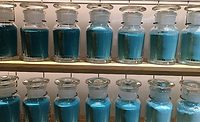HOUSTON – Rice University researchers have settled a long-standing controversy over the mechanism by which silver nanoparticles, the most widely used nanomaterial in the world, kill bacteria.
Their work comes with a Nietzsche-esque warning: Use enough. If you don’t kill them, you make them stronger.
Scientists have long known that silver ions, which flow from nanoparticles when oxidized, are deadly to bacteria. But scientists have also suspected silver nanoparticles themselves may be toxic to bacteria, particularly the smallest of them at about three nanometers. Not so, according to the Rice team that reported its results this month in the American Chemical Society journal Nano Letters.
In fact, when the possibility of ionization is taken away from silver, the nanoparticles are practically benign in the presence of microbes, said Pedro Alvarez, George R. Brown Professor and Chair of Rice’s Civil and Environmental Engineering Department.
Alvarez said the straightforward answer to the decade-old question is that the insoluble silver nanoparticles do not kill cells by direct contact. But soluble ions, when activated via oxidation in the vicinity of bacteria, do the job nicely.
To figure that out, the researchers had to strip the particles of their powers. “Our original expectation was that the smaller a particle is, the greater the toxicity,” said Zongming Xiu, a Rice postdoctoral researcher and lead author of the paper. Xiu set out to test nanoparticles, both commercially available and custom-synthesized from three to 11 nanometers, to see whether there was a correlation between size and toxicity.
“We could not get consistent results,” he said. “It was very frustrating and really weird.”
Xiu decided to test nanoparticle toxicity in an anaerobic environment – that is, sealed inside a chamber with no exposure to oxygen — to control the silver ions’ release. He found that the filtered particles were a lot less toxic to microbes than silver ions.
Working with the lab of Rice Chemist Vicki Colvin, the team then synthesized silver nanoparticles inside the anaerobic chamber to eliminate any chance of oxidation. “We found the particles, even up to a concentration of 195 parts per million, were still not toxic to bacteria,” Xiu said. “But for the ionic silver, a concentration of about 15 parts per billion would kill all the bacteria present. That told us the particle is 7,665 times less toxic than the silver ions, indicating a negligible toxicity.”
“The point of that experiment,” Alvarez said, “was to show that a lot of people were obtaining data that was confounded by a release of ions, which was occurring during exposure they perhaps weren’t aware of.”
Alvarez suggested the team’s anaerobic method may be used to test many other kinds of metallic nanoparticles for toxicity and could help fine-tune the antibacterial qualities of silver particles. In their tests, the Rice researchers also found evidence of hormesis; E. coli became stimulated by silver ions when they encountered doses too small to kill them.
“Ultimately, we want to control the rate of (ion) release to obtain the desired concentrations that just do the job,” Alvarez said. “You don’t want to overshoot and overload the environment with toxic ions while depleting silver, which is a noble metal, a valuable resource – and a somewhat expensive disinfectant. But you don’t want to undershoot, either.”
He said the finding should shift the debate over the size, shape and coating of silver nanoparticles. “Of course they matter,” Alvarez said, “but only indirectly, as far as these variables affect the dissolution rate of the ions. The key determinant of toxicity is the silver ions. So the focus should be on mass-transfer processes and controlled-release mechanisms.”
“These findings suggest that the antibacterial application of silver nanoparticles could be enhanced and environmental impacts could be mitigated by modulating the ion release rate, for example, through responsive polymer coatings,” Xiu said.
Co-authors of the paper are postdoctoral researcher Qingbo Zhang and graduate student Hema Puppala, both in the lab of Colvin, Rice’s Kenneth S. Pitzer-Schlumberger Professor of Chemistry, a Professor of Chemical and Biomolecular Engineering and Vice Provost for Research.
The work was supported by a joint U.S.-U.K. research program administered by the Environmental Protection Agency and the U.K.’s Natural Environment Research Council.






